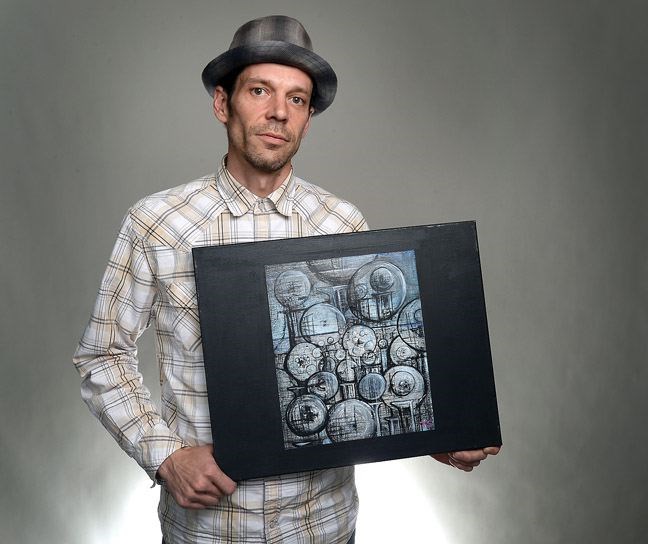Trevor Stanley is providing fresh I's on the Prince George arts scene.
After living in various places like Fort Nelson, Chetwynd growing up and most recently in Nova Scotia, Stanley has only been in P.G. since July of last year, but through family members (his mother is noted local musician Val Stanley) he has been plugged into this place for a big chunk of his adult life.
He is familiar enough to feel affinity for the place, and understand the currents and eddies of local culture, but removed enough to be objective about this new hometown he brought his young family to.
He was a well-known artist on the east coast and when he moved to Prince George "I didn't want to lose any of that momentum" so he sought out the local arts community. He found it, and was sucked inside like gasoline to a spark plug. The Community Arts Council got him an easel at Art Battle, and when he learned of the CAC's collaboration with the Prince George Citizen on a little initiative called The Alphabet Project he did the "pick me, pick me" dance for the organizers. And they did.
"I was lucky to get the I," he said. "I improvise a lot of things. I rarely have a set concept in mind when I start out on a painting. It is cathartic to just let it all flow and go wherever it takes me, and then I step back at the end and find the context inside it once it's done. But this was totally different. I knew I had to work with the idea of this letter of the alphabet."
He played with the letter in his mind, first. The seeing eye. Aye aye, captain. The great I Am. I as defines the individual in pronoun form.
"All those things had been done - the monolithic I," he said. "I didn't want just a big pulpmill stack or a tall tree representing the letter. I knew I didn't want to do anything literally regional. So I looked next at what it does in the alphabet. It's a vowel, so its job is to connect sounds and form those into words. Then I thought about what this project was all about, and how it was using letters differently then usual words on the newspaper page. It was making a statement about art, about culture, and what was it saying back about the newspaper? Newspapers deal in ink. It is also very industrial in the printing side of the business."
With this in mind, his eyes happen to land on a jar of India ink, and that ignited the initial concepts used in his final painting. While it looks like an oil painting at the casual glance, it is a combination of acrylics and a lot of India ink, with a work-over by that quintessentially industrial of tools, sandpaper.
"I love getting my hands dirty and inky," he said. "I'm a gear-head. I ride motorcycles. I like fixing engines. That's what I enjoy."
Flip through the below slideshow to view the Alphabet Project art and a link to each artist story:
There is a very short distance between the creative thoughts behind engines and automobile design and the creative thoughts behind paintings and sculptures. He also plays a number of musical instrument and sings and, again, the lines are short between that artistic pursuit and the world of cars, or any industrial activity, really, where the bottom line is using tools to create something different than what was there before.
"My daughter is four and I've actually sold her paintings before," Stanley said. "My middle son says he wants to be a painter. It's great for the kids to be able to see that kind of thing going on around the home. They identify me as an artist and they know that is valuable, despite the income it brings in. It's about the legacy it represents, and the way an artist can express ideas about themselves or their communities using all these parts the bring together."
He has a workaday profession as well, he is on the sales team for the Honda auto dealership, but he doesn't consider his music or his paintings to be hobbies. He invests numerous hours of practice per week so he can ply that sub-trade with confidence and knowledge.
Using it to be part of The Alphabet Project is seen by Stanley as doing community service of an important sort.
"If a community doesn't have its own creative culture, crime goes up, healthcare problems go up, education doesn't take root as much, and local recruitment and retention of positive professionals and families goes down," he said.
"A thriving arts scene gives a community a stronger sense of its own identity, it shows an encouragement of its people to do things and be makers of things and think things through a little better than other communities. It makes a city into a positive place that people want to move to, and want to stay and live in. It gives a community something that is there forever, stamped in ink, just like a newspaper does.
"Without art and without newspapers, you have no flow of deeper communication, and no community identity. There it is... I... identity."



